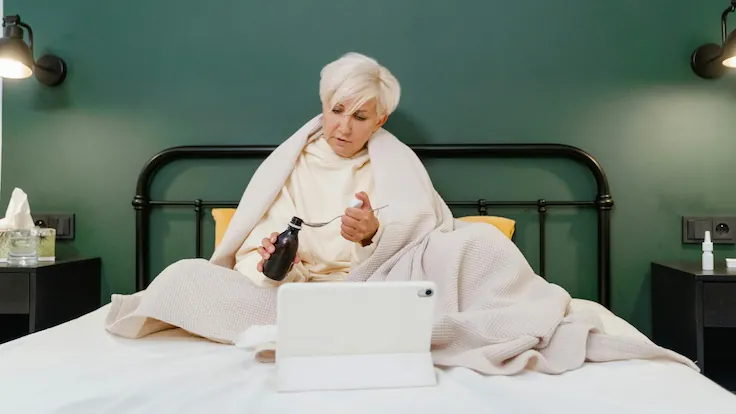Recover from Cholecystectomy with Dimer Health once you leave the hospital
Cholecystectomy is the surgical removal of the gallbladder, a small organ that stores bile. Post-acute care after cholecystectomy is important to ensure a smooth recovery and prevent complications.
Get a personalized care plan and 24x7 clinical support until you fully recover:
Schedule your video call with one of our experienced providers
We will create a personalized core plan and set follow up appointments as needed
You will have 24x7 support for any question via phone, text or web app
We accept most insurances and currently available in New Jersey and New York
How it works
What is Cholecystectomy
A cholecystectomy is a surgical procedure to remove the gallbladder, a small, pear-shaped organ located under the liver on the right side of the abdomen. The gallbladder stores bile, a fluid produced by the liver that helps digest fats. This procedure is most commonly performed to treat gallstones, which are solid particles that can form in the gallbladder and cause pain, infections, or blockages. Cholecystectomy is also recommended for other gallbladder conditions such as cholecystitis (inflammation of the gallbladder), gallbladder cancer, or pancreatitis related to gallstones.
Cholecystectomy can be performed using two methods: laparoscopic cholecystectomy or open cholecystectomy. Laparoscopic cholecystectomy is the most common and involves making several small incisions in the abdomen, through which surgical instruments and a camera are inserted to remove the gallbladder. This method typically results in less pain, shorter recovery time, and minimal scarring compared to open cholecystectomy, which requires a larger incision. After the surgery, patients may need to modify their diet temporarily and gradually reintroduce normal foods while the body adjusts to digesting fats without the gallbladder. Recovery times can vary, but many patients can return home the same day or the following day after laparoscopic surgery.
Please call or book an appointment with us if you are recovering from Cholecystectomy
Cholecystectomy Recovery Tips
Recovering from a cholecystectomy, the surgical removal of the gallbladder, typically involves a relatively quick recovery period, especially if the surgery was performed laparoscopically. Here are some tips to help you recover effectively after being discharged from the hospital:
Following these tips can help you recover more comfortably and effectively from Cholecystectomy.
- Follow Post-Surgical Instructions: Strictly adhere to any care instructions provided by your surgeon. This includes guidelines on how to care for your incisions, recognizing signs of infection, and when to resume normal activities.
- Manage Pain: Use pain relievers as prescribed by your doctor to manage discomfort. Over-the-counter pain relief medications may also be recommended to help you stay comfortable during your recovery.
- Rest and Gradually Increase Activity: Although you should rest immediately after surgery, it's also important to gradually increase your activity level. Start with short walks and slowly build up your endurance. This helps prevent complications such as blood clots and promotes healing.
- Monitor Your Incisions: Keep an eye on your incision sites for signs of infection such as redness, swelling, or discharge. If you notice any of these symptoms or develop a fever, contact your healthcare provider.
- Diet Adjustments: After a cholecystectomy, your body may need time to adjust to digesting fats without the gallbladder. Start with a low-fat diet and gradually reintroduce more normal foods as tolerated. Avoid spicy and greasy foods in the initial recovery phase.
- Stay Hydrated: Drinking plenty of fluids helps your body heal and can aid in preventing constipation, which is common after surgery.
- Avoid Lifting Heavy Objects: For several weeks after the surgery, avoid lifting anything heavier than 10 pounds to prevent strain on your incisions and reduce the risk of developing a hernia.
- Use Proper Techniques for Coughing or Sneezing: Support your abdomen with your hands or a pillow when coughing or sneezing to avoid putting extra pressure on the incision sites.
- Attend Follow-Up Appointments: Make sure to attend all follow-up appointments with your surgeon to ensure proper healing and to address any concerns you might have.
- Watch for Digestive Issues: Some people may experience changes in their digestion after gallbladder removal, such as diarrhea or bloating. If these symptoms persist, discuss them with your doctor, as dietary adjustments might help.
- Listen to Your Body: Pay attention to your body's signals and rest when you feel tired. Recovery times can vary, and it's important to allow your body to heal at its own pace.
By following these tips and maintaining open communication with your healthcare provider, you can help ensure a smooth and successful recovery following your cholecystectomy.
Don't navigate your recovery journey alone.
Let us be there for you every step of the way.


